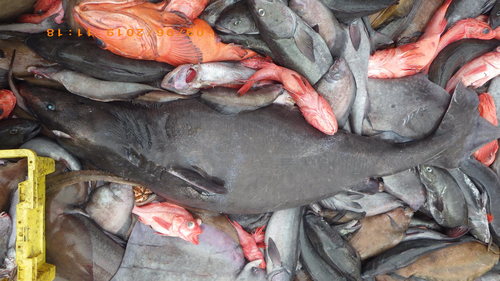
Pacific Sleeper Shark
The Atlantic bluefin tuna (Thunnus thynnus) is a magnificent and highly migratory species renowned for its size, speed, and commercial value. As a top predator, it plays a crucial role in the marine ecosystem. Sadly, intense fishing pressure has severely depleted its population.
unknown unknown years
Lifespan
440 cm
Length
Near Threatened
Conservation Status
unknown km/h
Swimming speed
Carnivorous, Scavengers
Diet
Local Migration
Migration
Appearance Overview
The Atlantic bluefin tuna is a large, streamlined fish with a metallic blue-black back and a silvery-white belly.
Coloration
Dark metallic blue on top, silvery-white underside
Body shape
Torpedo-shaped, built for speed and endurance
Fins
Two dorsal fins, the first is depressible, followed by finlets
Keels
Small keels on the caudal peduncle
Length
Up to 13 feet (4 meters)
Weight
Up to 2,000 lbs (907 kg)
Diet
Carnivorous, feeding on a variety of fish, squid, crustaceans, and eels.
Feeding Behavior
Highly active predator, using speed and agility to hunt. They often hunt cooperatively, herding and trapping prey.
Social Behavior
Forms large schools, especially during migrations. Schools may segregate by size.
Commercial Relevance
Extremely high value, particularly in the sushi and sashimi markets of Japan. Overfishing has significantly impacted populations.
Conservation measures
International fishing quotas, catch limits, and monitoring programs (ICCAT). Marine protected areas and efforts to reduce bycatch.
Status
Endangered (IUCN)
Threats
Overfishing (historically and continuing), bycatch in other fisheries, climate change affecting prey distribution.
Habitat Distribution
Depth Range
0-1,000 meters (typically in the epipelagic and mesopelagic zones)
Geographic Range
North Atlantic Ocean, Mediterranean Sea, and the Gulf of Mexico
Preferred Environment
Temperate and subtropical waters; pelagic (open ocean) and coastal areas.
Reproduction and Life Cycle
Breeding Habits
Spawns in warm waters, primarily in the Mediterranean Sea and the Gulf of Mexico, during specific seasons.
Development Stages
Eggs hatch into larvae, which develop rapidly. Juveniles grow quickly, eventually reaching impressive sizes.
Fecundity
Females can release up to 30 million eggs per spawning season.
Maturity Age
Reaches sexual maturity at around 4-8 years in the eastern Atlantic and Mediterranean, and 9-12 years in the western Atlantic.
Faqs about Pacific Sleeper Shark
How fast can Atlantic bluefin tuna swim?
Atlantic bluefin tuna are among the fastest fish in the ocean, capable of bursts of speed up to 40-60 mph.
How long do Atlantic bluefin tuna live?
They can live up to 40 years, although many don't reach this age due to fishing pressure.
Are bluefin tuna warm-blooded?
Yes, they are warm-blooded, which allows them to maintain a higher body temperature than the surrounding water, aiding in muscle efficiency.
Where are Atlantic bluefin tuna found?
Atlantic bluefin tuna are found in the Atlantic Ocean, from the Mediterranean Sea to the Gulf of Mexico, and from Newfoundland to Brazil.
Why is bluefin tuna so expensive?
The high demand for bluefin tuna, especially in sushi, drives up the price, making it one of the most expensive fish.
How do Bluefin Tuna stay warm?
Bluefin tuna have a specialized blood vessel structure called a countercurrent heat exchanger, which helps them retain heat.
Can Bluefin tuna be kept in an aquarium?
Their large size, fast speeds, and schooling behavior make them challenging to keep in captivity.
Where do Bluefin Tuna spawn?
Spawning primarily occurs in the Mediterranean Sea and the Gulf of Mexico.
Copyright @ Nature Style Limited. All Rights Reserved.
 English
English